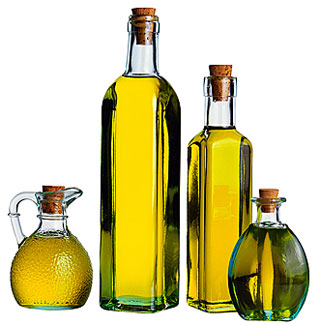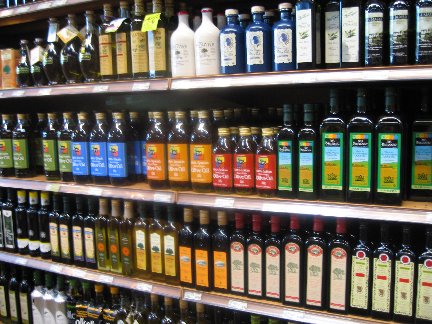General goods & Condiments
1. rice
2. dried pasta in different shapes
3. dried onion soup mix
4. tomato paste
5. tomato sauce
6. canned tomatoes
7. peanut butter
8. jelly
9. canned tuna
10. raisins
11. chocolate syrup
12. cereals
13. chicken or beef stock
14. canned soups
15. canned beans
16. olives
17. canned pears
18. canned peaches
19. applesauce
20. vegetable oil
21. olive oil
22. red wine vinegar
23. white wine vinegar
24. vegetable shortening
25. nonstick cooking spray
26. mayonnaise
27. ketchup
28. mustard
29. salad dressings
30. soy sauce
31. hot pepper sauce
32. Worcestershire sauce
33. barbecue sauce
34. salsa
35. honey
36. maple syrup
37. white wine for cooking
38. red wine for cooking
39. Mango Chutney
20) vegetable oil
Vegetable fats and oils are lipid materials derived from plants. Physically, oils are liquid at room temperature, and fats are solid. Chemically, both fats and oils are composed of triglycerides, as contrasted with waxes which lack glycerin in their structure. Although many different parts of plants may yield oil, in commercial practice, oil is extracted primarily from seeds.
The melting temperature distinction between oils and fats is imprecise, since definitions of room temperature vary, and typically natural oils have a melting range instead of a single melting point.
Vegetable fats and oils may be edible or inedible.
I’m not going to do a dissertation on the health or unhealthy use of oil, except to say, when cooking with oil, any oil, never let it go above 400 deg. The oil will breakdown at those temperatures and produce very unhealthy bi-products.
Pure vegetable oil like Wesson should be used sparingly. Yes, you need it in the pantry, but don’t use it as a first choice. Use, in this order, Olive oil, Canola oil (rapeseed), Safflower oil and peanut oil. When frying at high temps (375 degs max) the use of peanut oil is better because it holds up at high temps better.
Negative health effects
A high consumption of omega-6 polyunsaturated fatty acids (PUFAs), which are found in most types of vegetable oil (e.g. soybean oil, corn oil – the most consumed in USA, sunflower oil, etc.), may increase the likelihood that postmenopausal women will develop breast cancer[18]. Similar effect was observed on prostate cancer[19]. Other analysis suggested an inverse association between total polyunsaturated fatty acids and breast cancer risk[20].
21) olive oil

I use olive oil almost exclusively, even when I pan fry.
Retail grades in IOOC member nations
In countries which adhere to the standards of the IOOC the labels in stores show an oil’s grade. The US is not a member.
Extra-virgin olive oil comes from cold pressing of the olives, contains no more than 0.8% acidity, and is judged to have a superior taste. Extra-virgin and virgin olive oil may not contain refined oil.
Virgin olive oil has an acidity less than 2%, and is judged to have a good taste.
Pure olive oil. Oils labeled as Pure olive oil or Olive oil are usually a blend of refined and virgin or extra-virgin oil.
Olive oil is a blend of virgin oil and refined oil, of no more than 1.5% acidity. It commonly lacks a strong flavor.
Olive-pomace oil is a blend of refined pomace olive oil and possibly some virgin oil. It is fit for consumption, but may not be described simply as olive oil. Olive-pomace oil is rarely sold at retail; it is often used for certain kinds of cooking in restaurants.
Lampante oil is olive oil not suitable as food; lampante comes from olive oil’s long-standing use in oil-burning lamps. Lampante oil is mostly used in the industrial market.
Label wording
Olive oil vendors choose the wording on their labels very carefully.
“100% Pure Olive Oil” is often the lowest quality available in a retail store: better grades would have “virgin” on the label.
“Made from refined olive oils” means that the taste and acidity were chemically controlled.
“Light olive oil” means refined olive oil, with less flavour. All olive oil has 120 Calories per tablespoon (34 KJ/ml).
“From hand-picked olives” implies that the oil is of better quality, since producers harvesting olives by mechanical methods are inclined to leave olives to over-ripen in order to increase yield.
“First cold press” means that the oil in bottles with this label is the first oil that came from the first press of the olives. The word cold is important because if heat is used, the olive oil’s chemistry is changed. It should be noted that extra-virgin olive oil is cold pressed, but not necessarily the first oils.
The label may indicate that the oil was bottled or packed in a stated country. This does not necessarily mean that the oil was produced there. The origin of the oil may sometimes be marked elsewhere on the label; it may be a mixture of oils from more than one country.
Retail grades in the United States from the USDA
As the United States is not a member, the IOOC retail grades have no legal meaning in that country; terms such as “extra virgin” may be used without legal restrictions.
The U.S. Department of Agriculture (USDA) currently lists four grades of olive oil. These grades were established in 1948, and are based on acidity, absence of defects, odor and flavor:
U.S. Grade A or U.S. Fancy possesses a free fatty acid content of not more than 1.4% and is “free from defects”
U.S. Grade B or U.S. Choice possesses a free fatty acid content of not more than 2.5% and is “reasonably free from defects”
U.S. Grade C or U.S. Standard possesses a free fatty acid content of not more than 3.0% and is “fairly free from defects”
U.S. Grade D or U.S. Substandard possesses a free fatty acid content greater than 3.0% “fails to meet the requirements of U.S. Grade C”
These grades are entirely voluntary and are available from the USDA on a fee-for-service basis.
****Now that I have totally confused you I will summarize: Buy Extra-virgin olive oil that is from the first COLD pressing. Don’t buy anything else and buy the most expensive oil you can justify. And usually, the greener the oil the better. I have found that Trader Joe’s has an excellent oil at a very reasonable price.
22) red wine vinegar
Wine vinegar is either made from red or white. Cooks use vinegar for many purposes such as; pickling, deglazing pans, marinating meats, making sauces and is found in certain desserts. Red wine vinegar is commonly used in the Mediterranean countries, being a common staple in most French homes. There are several different qualities of red wine vinegar. The longer the wine vinegar matures, the better it is. Most red wines can be matured up to two years. White wine vinegar is a moderately tangy vinegar that French cooks use to make Hollandaise and Béarnaise sauces, vinaigrettes, soups, and stews. It’s also an excellent base for homemade fruit or herb vinegars
Season: available year-round
Substitutions: red wine vinegar, champagne vinegar, rice vinega, cider vinegar, white wine vinegar, balsamic vinegarr, sherry vinegar or apple cider vinegar
23) white wine vinegar
See Red wine vinegar
24) vegetable shortening
I’ve made this real big so you would read this. Don’t use shortening, is my recommendation!
Shortening is a semisolid fat used in food preparation, especially baked goods, and is so called because it promotes a “short” or crumbly texture (as in shortbread). The term “shortening” can be used more broadly to apply to any fat that is used for baking and which is solid at room temperature, such as butter, lard, or margarine, but as used in recipes it refers to a hydrogenated vegetable oil that is solid at room temperature. Shortening has a higher smoke point than butter and margarine, and it has 100% fat content, compared to about 80% for butter and margarine.
Although the term has been in use for many years it is now known that shortening works by inhibiting the formation of long protein (gluten) strands in wheat-based doughs. The similarity in terms is entirely coincidental since full understanding of the structure and chemistry of dough is comparatively recent.
History
Crisco, a popular brand in the USA, was first produced in 1911. In Ireland and the UK Cookeen is a popular brand. An industrial product, shortening has many advantages. While similar to butter or lard, it is cheaper to produce; originally, lard was far cheaper and edible oils came at a higher cost. Shortening also needs no refrigeration, which further lowers its costs and increases its convenience. As a substitute for butter, it can lengthen the shelf life of baked goods and other foods. With these advantages shortening gained popularity, as food production became increasingly industrialized and manufacturers sought low-cost raw materials. Vast surpluses of cottonseed oil, corn oil, and soy beans helped found a market in low-cost shortening.
Health concerns and reformulation
Available and used worldwide, vegetable shortening is believed to be damaging to human health since it generally contains trans fats in the form of partially hydrogenated vegetable oil. After the oils are hydrogenated they become solid at room temperature, but the type of trans fat generated in this process has adverse health effects. Usage of shortening lacking trans fats has grown, notably with the 2007 reformulation of Crisco such that it contains less than 1g of trans fat per 12g serving. Cookeen was also reformulated in autumn 2006 to remove trans fats[1]. Non-hydrogenated vegetable shortening can be made from palm oil.
Comparative properties of common cooking fats (per 100g)
Total Fat Saturated Fat Monounsaturated Fat Polyunsaturated Fat Protein
Butter 81g 51g 21g 3g 1g
Vegetable Shortening (hydrogenated) 71g 23g 8g 37g 0g
Olive Oil 100g 14g 73g 11g 0g
Lard 100g 39g 45g 11g 0g
To sum up: The new Crisco STILL has some transfat in it. Look other brands that are labeled NO TRANS FATS if you want to avoid that completely.
Update- so you’ll know the facts:
In April 2004, Smucker introduced “Crisco Zero Grams Trans Fat Per Serving All-Vegetable Shortening,” which contained fully hydrogenated palm oil blended with liquid vegetable oils to yield a shortening much like the original Crisco. As of January 24, 2007, all Crisco shortening products have been reformulated to contain less than one gram of trans fat per serving. The separately marketed trans-fat free version introduced in 2004 was discontinued. Crisco now consists of a blend of soybean oil, fully hydrogenated cottonseed oil, and partially hydrogenated soybean and cottonseed oils. According to the product information label, one 12 g serving of Crisco contains 3 g of saturated fat, 0g of trans fat, 6 g of polyunsaturated fat, and 2.5 g of monounsaturated fat. It is claimed that this reformulated Crisco has the same cooking properties and flavor as the original version of the product.
According to the FDA website, “Food manufacturers are allowed to list amounts of trans fat with less than 0.5 gram (1/2 g)per serving as 0 (zero) on the Nutrition Facts panel.”
Controversy
Some nutritionists are already warning that Crisco’s formula change may be nutritionally irrelevant. They argue that fully hydrogenated oil may not be any healthier than trans-fat containing partially hydrogenated oil. Crisco and similar low trans-fat products are formed by the interesterification of a mixture of fully hydrogenated oils and partially hydrogenated oils. The result is “artificial” insofar as the composition of the resultant triglycerides is random, and may contain combinations of fatty acids not commonly found in nature. A recent study showed that interesterified fat increased volunteers’ blood sugar by 20 percent while simultaneously lowering the body’s “good” HDL cholesterol. The rise in blood sugar is problematic since it increases the chance of developing type 2 diabetes, already a growing problem in the US.
Since cotton crops are under far less chemical regulation that other other crops used specifically for food, many pesticides or chemicals can be used on cotton crops that are illegal for use on food crops, yet the cottonseed can find it’s way into the food chain because of this major legal loophole in the regulation of food and chemicals by the FDA. Some serious pesticides or chemicals could resist processing and find their way into the food chain because of this.
25. nonstick cooking spray
These can be really good products. I use three different ones. I use the the original Pam, the High Heat Pam for grilling, a Baker’s no-stick spray with flour in it and an Olive oil spray. Just remember that most of these sprays are flammable if not because of the propellant, because of the oil. And also remember to use a small amount. The smaller the better. If you’d like to know some alternate uses for cooking spray, go to this site:
http://www.associatedcontent.com/article/496283/alternative_uses_for_cooking_spray.html?cat=22
26. mayonnaise
This topic could be very long and drawn out, so I’ll make it easy. I make my own mayonnaise about 1/4 of the time. Other than that I would rather do without than use anything but Hellman’s Original Mayo. I’ve tried them all and I only like my own or Hellman’s. I even HATE so called “Salad Dressing”. I’d love to hear what you guys think about this. – Jug

